Super heavy sledgehammer of the Second Polish Commonwealth
Some experience with the use of heavy guns. The Polish Army has already had. In 1920, a batch of 210-mm mortars was bought in Italy. In early August, eight of these guns entered service with the 1 th super-heavy artillery regiment (1. Pułk motorowy artylerii najcięższej). In September, the 1920 battery of the 1 regiment participated in the battles for Grodno against units of the Red Army. Following the results of the combat use of heavy artillery systems, it was concluded that their presence in the Polish Army was expedient, but the existing 210-mm mortars recognized that they were not completely meeting the army requirements and were to be replaced.
Long search for a new artillery system
For several years, no efforts were made to modernize the super-heavy artillery fleet - the Polish government lacked other concerns. Only the beginning of work to strengthen the eastern borders of Germany prompted the leadership of the Second Polish-Lithuanian Commonwealth to look for an adequate response. The process of selecting and purchasing guns moved slowly. In 1927, the General Headquarters of the Polish Army made a protocol decision on adopting large-caliber guns capable of destroying light and medium-sized fortifications erected in German fortified areas. Since the Polish industry was unable to produce such artillery systems, the choice fell on a foreign firm that enjoyed a well-deserved reputation in this area - the Czechoslovak Skoda.
In October, the Polish military commission visited the Malacky training ground near Bratislava, where it observed the tests of the 1929-mm mortars ON - the gun made a favorable impression on the Poles. The commission recommended adopting it, demanding that the wedge valve be replaced with a piston (Schneider system), which, according to the Polish military, was more suitable for heavy artillery systems. This demand became a stumbling block - Skoda tried hard to defend its design intact. Only in 220, the parties were able to reach an agreement, and the Polish government approved a plan to purchase forty 1931-mm mortars in two batches (220 units - first of all, 27 - in the second). In the second half of 13, the Department of Arms and Artillery of the Ministry of Military Affairs prepared the technical requirements for the 1932-mm mortar, and 220 in March of the following year finally signed the first batch contract - 7 mortars and 27 semi-armored projectiles (the acquisition plan for the second batch did not was implemented). The cost of one mortar was determined in 2700 700 zł, and the payment was made in kind - the supply of Polish coal.
Since 1931, the Polish military has been looking for a suitable tractor for the new heavy mortars. In 1934, their choice rested on the C7R crawler tractor, developed at the state enterprise “Pannstove Engineering Mortgages” on the basis of the Vickers design (the tractor was unified with light a tank 7TP). In addition, Poland developed the R-type biaxial trailer (8000 kg curb weight), designed for transporting ammunition to mortars. According to the accepted standards, each of these guns was given two such trailers towed by S7P tractors. But since the production of tractors was extremely slow, Fiat 621 trucks, manufactured under an Italian license and equipped with special bodies, were used as their temporary replacement.
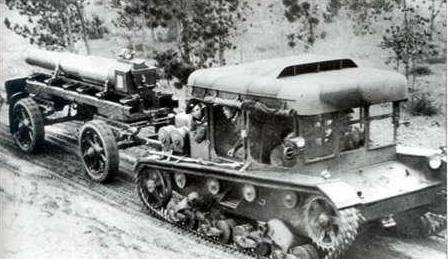
220-mm mortar wagon towed by C7P
In order to familiarize the 1 personnel of the super heavy artillery regiment with the new systems, Skoda provided for temporary use one sample of a Yugoslav type M 28 mortar (with a wedge gate; Yugoslavia acquired ten such guns). By the end of September, 1934 had trained the personnel of the regiment in handling the new weapon, after which the training of recruits began. In November, a test run was carried out, which showed a number of transport vehicle defects: an unsuccessful design of the brakes; poor barrel mount on the barrel wagon; loosening screws, nuts and rivets. Carriage based on gun wagons was considered exhausting and simply dangerous for personnel. The result was a recommendation to replace the wheels of carts, using pneumatics instead of steel tires with rubber bands.
Deliveries of mortars that received the designation 220 mm możdzierz wielkiej mocy wz in the Polish Army. 32 (220-mm mortar high power sample. 32; brand designation - ONa), began in 1935 year. By July, the army received the first dozen of new artillery systems, and by December another fifteen had been delivered.
Design features
Mortar wz. 32 had an autofreted barrel with a length of 15,5 caliber with a piston gate of the Schneider system. Assembled with a bolt barrel weighed 4350 kg. The recoil brake is hydraulic, and the knurler is pneumatic. The design of the gun provided circular horizontal fire and was optimized for firing at high elevation angles.
The barrel of the gun was installed in the cradle, which was attached to the machine by means of pins. The machine was based on the base platform through a circular ball shoulder strap. Adjustable bed mounted at the corners of the platform contributed to increasing the stability of the gun when firing. The ends of the beds relied on the coulter supports with ball screws.
The transportation of the gun was carried out by three carriages: the barrel (curb weight - 8090 kg); carriagehouse (curb weight - 8110 kg); base (curb weight - 8950 kg). The permissible towing speed on the highway was 30 km / h.
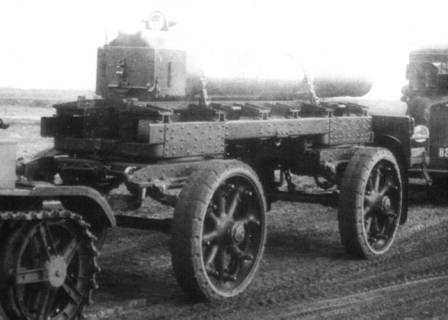
Barrel wagon mortar wz. Xnumx
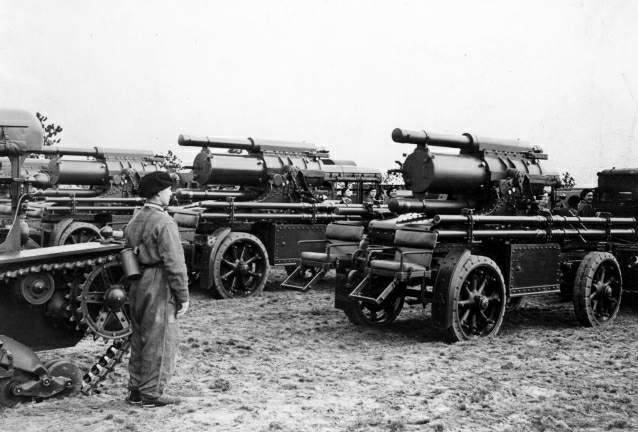
Lafteed wagons mortars wz. Xnumx
To install the gun in position, a pit would need to be prepared with a size of 3 x 4 m and a depth of 0,5 m. A cart with a base was rolled into the pit and lowered onto the ground with the help of hydraulic jacks. Then a carriage with a carriage was driven into the base, which was also put in place with the help of jacks. At last, the barrel wagon was rolled up, hoisting the barrel on the carriage with the help of a winch. According to the instruction, the entire operation of assembling the instrument, carried out by the calculation of 17 people, took five and a half hours, but the trained personnel managed to do it, as a rule, faster. To dismantle the gun was given two and a half hours.
Mortar was loaded at a fixed elevation angle + 10 °. The projectile was delivered to the gun by four carriers (altogether there were eight carriers) on a trolley or stretcher. The mortar ammunition consisted of a single type of projectile - a semi-armor weighing 128 kg, loaded with a charge of TNT weighing 7,33 kg.
There were six propellant charges weighing from 3,78 to 8,92 kg. Since November 1936, the Poles have independently developed a high-explosive projectile, characterized by a greater range of fire and an increased explosive charge, but thinner walls. It was assumed that it could be used not only against fortifications, but also against field-type targets — for example, manpower or artillery positions. Tests of the first high-explosive projectile samples demonstrated their poor stability, leading to significant dispersion. The problem was solved by the 1939 year, when acceptable tests were achieved on the tests of the next batch of modified shells. The delivery of the industrial lot was scheduled for 1940 year, but for obvious reasons it did not take place.
To save expensive imported projectiles and preserve the life of the barrels during firing practice, Škoda delivered to Poland two loose barrels for 220-mm mortars, which provided firing with 100-mm howitzer shells wz. 14 / 19p.
Service and combat use
Before the start of World War II, the Ministry of Military Affairs acquired the necessary equipment and means of thrust for the three divisions of the 220-mm mortars, each of which consisted of three two-gun batteries. The budget for 1940 for the year included the purchase of tractors for the fourth division, but for the time being the tools intended for it were placed at the Main Weapons Depot No. 2 in Stawy near Deblin.
In accordance with the “Z” defense plan, the 1 th super-heavy artillery regiment in August 1939 mobilized three divisions: the 11 under the command of Major Casimir Firli; 12 - Major Alexander Tochinsky; 13 - Major Hussein Kumuz. Each division had a solid fleet of vehicles, including the 33P 7 (five for each gun: three for gun carts, two for ammunition trailers plus one backup for the battery), 15 cars, 39 trucks, 37 specials and 12 motorcycles.
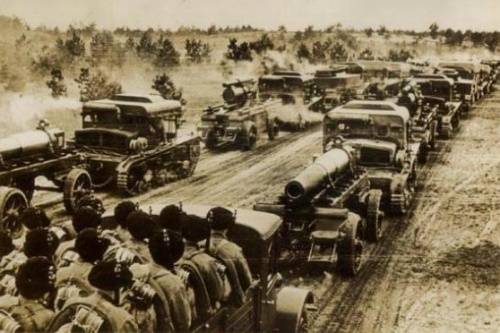
All three divisions were intended for the Prussians' reserve army, but due to the rapid advance of the German troops, they could not come at the disposal of its commander.
In the battles of the September 1939 campaign of the year, Polish 220-mm mortars had to solve at all those tasks for which they were acquired. Instead of storming the German fortifications, super-heavy artillery operated in field battles, for which it was of little use. As a result, out of the eighteen mobilized guns, only six mortars of the 11 Division - 22 and 23 of September took real part in the battle; they supported the Polish infantry in the Tomaszow-Lubelski area. As was to be expected, the effectiveness of the use of semi-armor shells in a field battle was low: 128-kg ammunition formed huge craters, but gave only a small amount of fragments. The psychological effect turned out to be more significant: under the fire of Polish mortars, units of the German 28 Infantry Division left the occupied positions twice. In the end, the 11-th division shot all the shells that were available, after which his mortars were blown up in positions at the forestry of Mazarnia.
The 12 and 13 divisions, which were moved from place to place by order of the command, did not shoot a single shot. The 13 Division of September 18 was located in Berezhany, where it was attacked by the OUN battle group. Subsequently, he was surrounded by units of the Red Army in the vicinity of Kalush and surrendered. The guns became Soviet trophies, but there is no information about their further fate. The 12 Division existed a little longer, until 25 September hit the Soviet environment south of Dolgobychuva (near Hrubieshov). In this case, the Poles managed to destroy their guns.
What was the fate of the other nine 220 mm mortars? One of them was located at the Ballistic Research Center in Zelentsa, where it was used to test new projectiles. Since the tractor to this mortar was absent, when the Germans approached it undermined. Another weapon was located in the Spare center of the motorized artillery in the town of Goura Kalwaria (the place of permanent deployment of the 1 th super-heavy artillery regiment). 10 September it fell into the hands of the enemy intact. Seven mortars, stored in a warehouse in Stawy, were also captured by the Nazis. German sources indicate that the Wehrmacht captured fourteen 220-mm mortars in Poland - perhaps, this number included the guns of the 11 division.
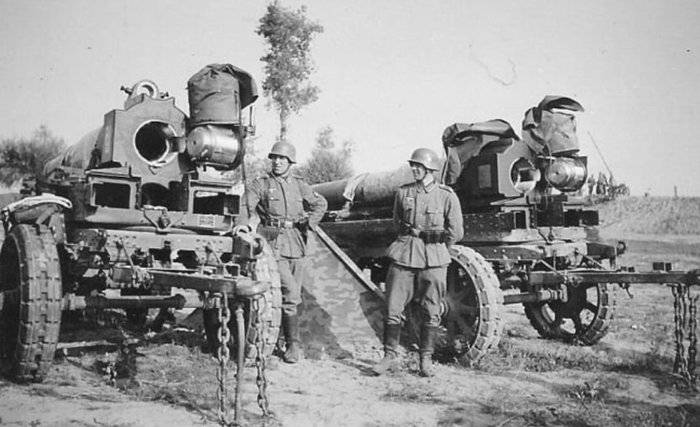
German trophies
In the Wehrmacht mortars wz. 32 assigned the designation 22 cm Mrsk. Seven of them were transported to Norway in 1941 – 1942 and installed on coastal batteries in Kroken, Hätlefloten, Klinga and Reitan, the fate of the other seven remains unknown. Be that as it may, some guns that had fallen into Norway, after the war, served for some time in its coastal artillery.
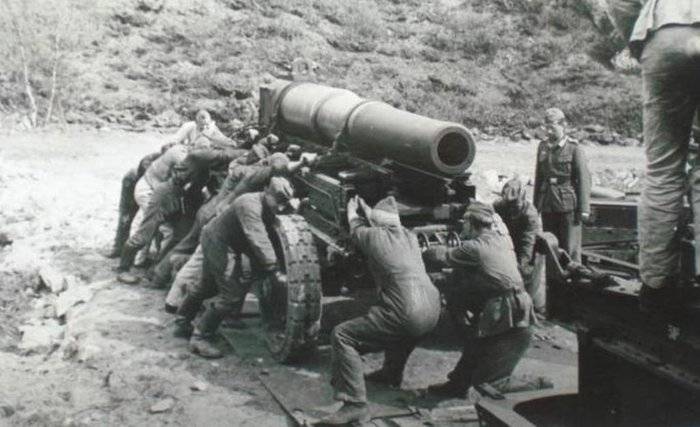
Installation of the barrel on the carriage mortar wz. 32 was not easy even for "purebred Aryans"
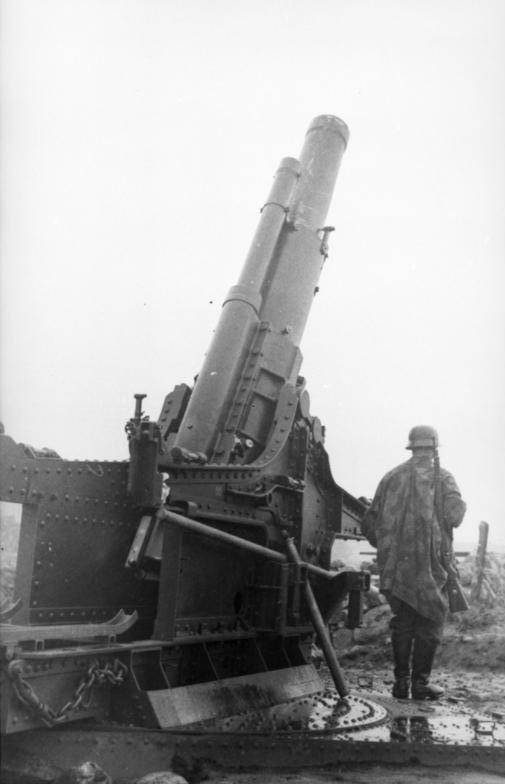
Trophy 220-mm mortar on the German coastal battery in Norway
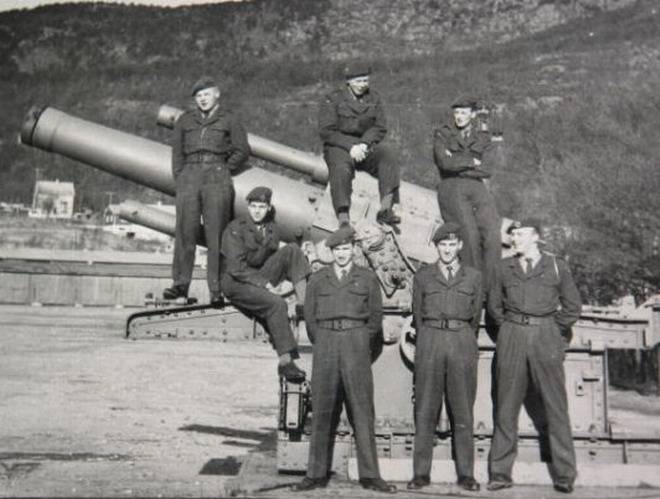
Norwegian gunners pose with 220-mm mortars, 1953 – 1954 years
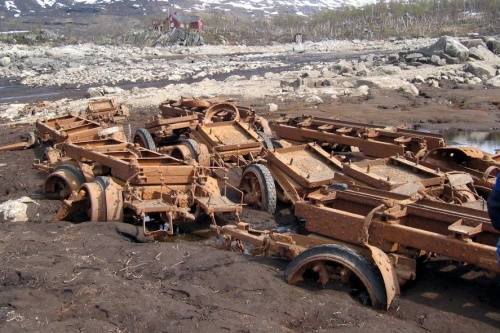
220-mm mortars, found in 2014, in the Norwegian lake Evre-Yernavannet
History The purchase and combat use of Poland 220-mm mortars is a textbook example of how not to buy weapons. The acquisition, planned in the same military-political situation, turned out to be completely meaningless in the new circumstances that had formed at the time of the transaction. In the middle of the 20-s, Poland could well count on success in an offensive war against Germany - in this case 220-mm mortars would be quite useful in the assault of enemy fortifications. But a decade later, when the super-heavy weapons finally entered service, the situation was not at all in favor of Poland - now the Polish military doctrine has become defensive, and the siege weapons did not fit into it. In the September defensive war, less than a quarter of the existing 220-mm mortars took part - moreover, the Poles were able to use them only in one battle.
Performance characteristics 220-mm mortars wz.32
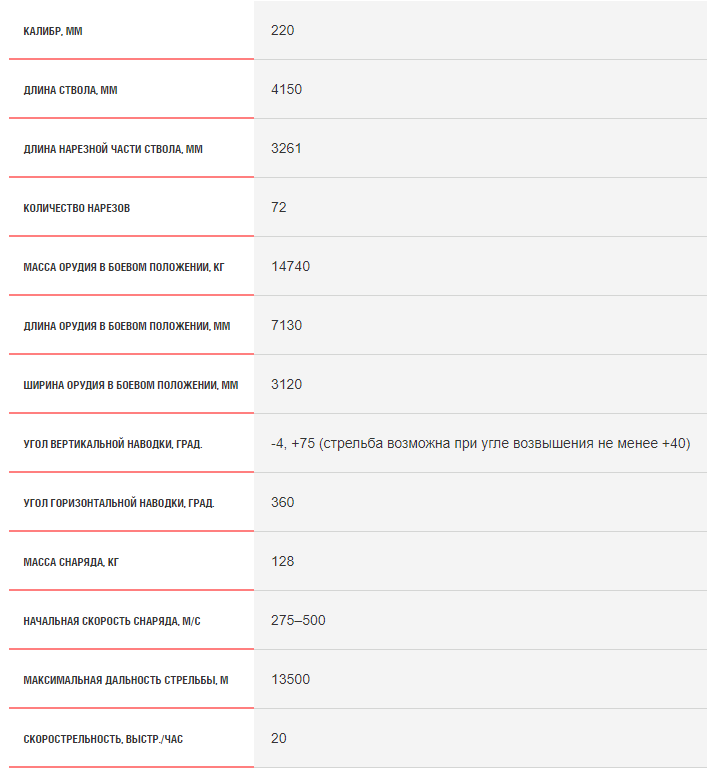
Information